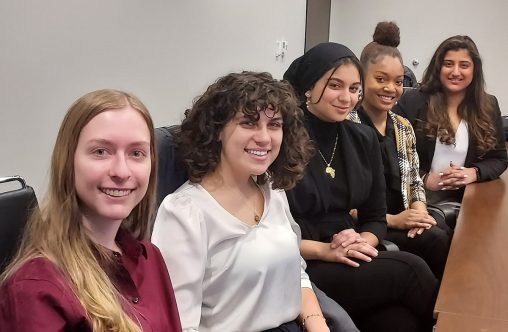
From left: Wright State medical and biomedical engineering students Celeste Hicks, Ellen Model, Fatima Boumahchad, Brie Williams and Akshima Dhiman presented their research on traumatic brain injury to the United States Army.
Wright State University medical and biomedical engineering students recently presented their research on traumatic brain injury to the United States Army.
The group of students is researching the relationship between biomarkers found in the bloodstream following traumatic brain injury (TBI) and symptoms and severity of injury.
Their work is coordinated by Tarun Goswami, D.Sc., professor of biomedical, industrial and human factors engineering in the College of Engineering and Computer Science and associate professor of orthopedic surgery in the Boonshoft School of Medicine. Goswami said the collaboration between biomedical engineering and medical students has been beneficial to the research.
Celeste Hicks, a senior majoring in biomedical engineering, said her research uses molecular dynamic simulations and molecular dynamic modeling to identify biomarkers in the blood as a way to quantitatively evaluate the severity of TBI.
She said that TBI is currently diagnosed qualitatively, or based on the symptoms patients describe following an injury. Since these descriptions are subjective and vary, they cannot be standardized or quantified to provide the most accurate diagnosis. The use of biomarkers to identify specific symptoms allows for more quantitative and measurable results.
Sheila Galbreath, a doctoral biomedical engineering student, said that being able to look at biomarkers that can be taken with a blood draw, as opposed to exposing a patient to radiation from a CT scan, will ultimately be more beneficial from a diagnostic perspective.
Since symptoms of TBI are often similar to those found in other brain ailments, the students have been exploring how to quantify those through the use of biomarkers as well.
Second-year medical students Ellen Model and Fatima Boumahchad are exploring the use of biomarkers in diagnosing Parkinson’s disease.
Brie Williams, who is also a second-year medical student, is researching biomarkers related to major depressive disorders and the overlap with post-traumatic stress disorder and Alzheimer’s disease.
Akshima Dhiman, a second-year medical student, previously worked with Hicks on the TBI biomarkers project. Her role was to determine how the biomarkers got from the brain to the blood. She expanded her research into diagnosing traumatic brain injuries effectively using mathematical formulas determining how much force each area of the brain can take before it reaches the minimum level of injury. This data, she hopes, will help to eliminate false negatives and positives and save more lives and money by not over- or underdiagnosing patients.
Dhiman said that she was excited to have the opportunity to present to the U.S. Army representatives, not only for the experience that she would gain by presenting her research but also with the hope that by sharing their findings with such an influential group of scientists, the research may someday be used in real-life practice and make an impact on the world by saving lives.
“Eventually we know that military-grade technology and medicine can be extended to the civilian life, much like the GPS, which was originally developed by the military and is now used by everyone in their cars and phones,” Dhiman said. “I hope that once we have breakthroughs in TBI in military scenarios, we can apply that to sports injuries, injuries in car crashes and much more.”

 Milling around
Milling around  Wright State recognizes Nursing Professor Kim Ringo for advancing international student success
Wright State recognizes Nursing Professor Kim Ringo for advancing international student success  Wright State honors graduating students for distinguished doctoral dissertations
Wright State honors graduating students for distinguished doctoral dissertations  Top 10 Newsroom videos of 2025
Top 10 Newsroom videos of 2025  Museum-quality replica of historic Hawthorn Hill donated to Wright State
Museum-quality replica of historic Hawthorn Hill donated to Wright State 